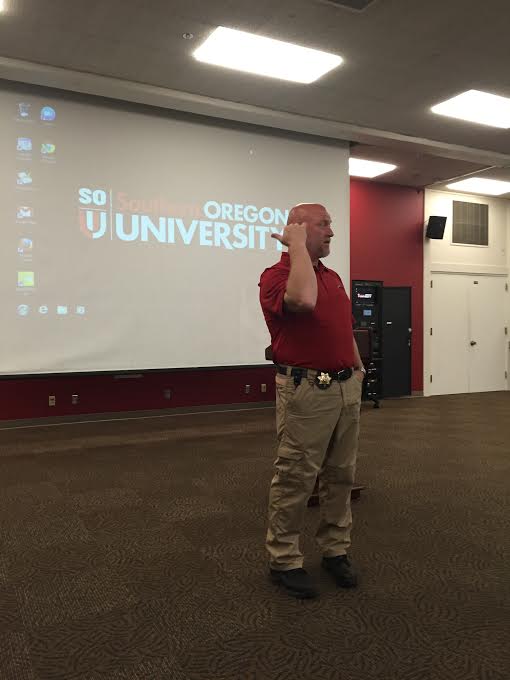Your chances of getting struck by lightning are about the same as an active shooter attacking your school. Despite the odds against it universities and colleges are offering preparation courses to ease the minds of students and instructors worried about an “Active Shooter” scenario.
In response to the recent shootings at Umpqua Community College and threats of violence against SOU, SOU has decided to host training sessions over the next several weeks. Instructed by Coordinator of Campus Public Safety, Frederick Creek, and supported by the Ashland Police Department, the sessions aim to prepare students and faculty for an active shooter situation.
“It is critical to have a survivor’s mindset,” Creek said in the first session Wed. Oct. 14. A release by the University explains that the sessions are meant to do just that. Get students in a mind set so, if an active shooting situation is happening on campus, they can safely make educated decisions and survive.
The two remaining sessions are listed below:
Wednesday, Oct. 28, 12:30 – 1:30 p.m. in the Rogue River Room in the Stevenson Union
Wednesday, Nov. 4, 12:30 – 1:30 p.m. in the Rogue River Room in the Stevenson Union
Creek stresses the fact that every active shooter situation is unique in its own way and it is up to the individual to prepare themselves accordingly. “You are responsible for your own personal safety” he explains “it is your decision to make.”
For readers who can not attend the sessions, the options available to you can be divided into three basic points. In no particular order they are as follows:
- Get Out
- Hide Out
- Take Out
One viable option is to get out while you can. If shooting sounds like it is far away and there does not appear to be any immediate danger, a student may choose to evacuate campus. Just be sure to check around corners and get to safety as quickly as possible.
If evacuating campus is not an option, then hiding out may be the way to go. Turn off the lights if you are in a classroom and spread out. When students bunch up together it makes for a bigger target and exposes you to more danger. Just be aware that if police find you hiding do not make any sudden movements or expect them to escort you out. The police’s first priority is to stop the shooter and end the violence.
Finally if all else fails as a last resort you may have to try to disable the shooter. Find something that will work as a weapon, be it a heavy book or pepper spray and try to incapacitate the shooter. Creek also tells students to be wary of bringing weapons on campus, such as pepper spray or a knife, unless you have had proper training. “If you don’t have training then you can potentially hurt yourself or give the shooter another weapon,” he said.
Now you may be asking, if an active shooter is on campus shouldn’t I just do whatever my professor says? Well Creek explains that the University has a clear policy of viewing students as adults. While it is the hope that faculty members will form quick decisions and lead their students to safety, students are free to make their own decisions
Students who attended the sessions say that the most useful information came in the form of small details that most people wouldn’t think of. Joseph Tiernan a senior, supported this saying, “they said when a gun goes off most people don’t recognize it because a real gun doesn’t sound like it does in the movies. That’s something people should know.”
Another way Creek says students can prepare for an emergency situation is to sign up for SOU Alerts. Imploring students to sign up because “If you don’t it is going to be very difficult to communicate with you, and that can make the difference.”
Every second counts, quick thinking with proper preparation can and will save your life.




